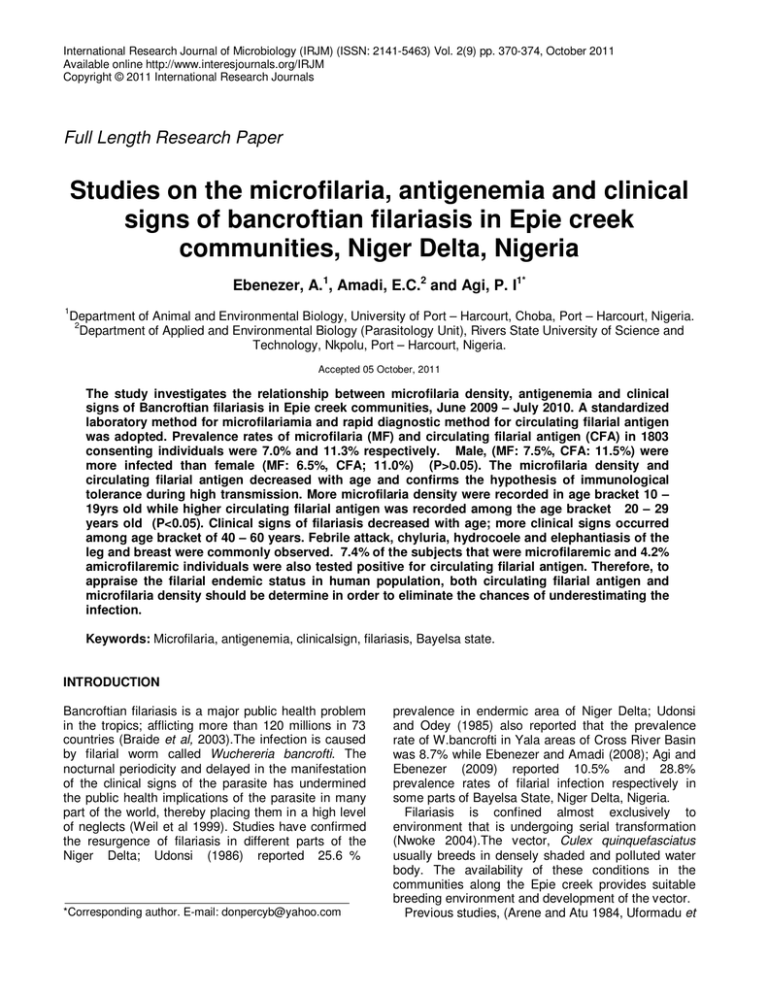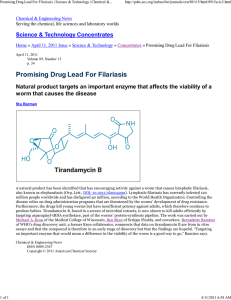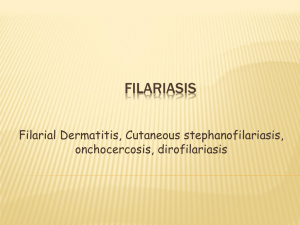Document 14111251
advertisement

International Research Journal of Microbiology (IRJM) (ISSN: 2141-5463) Vol. 2(9) pp. 370-374, October 2011 Available online http://www.interesjournals.org/IRJM Copyright © 2011 International Research Journals Full Length Research Paper Studies on the microfilaria, antigenemia and clinical signs of bancroftian filariasis in Epie creek communities, Niger Delta, Nigeria Ebenezer, A.1, Amadi, E.C.2 and Agi, P. I1* 1 Department of Animal and Environmental Biology, University of Port – Harcourt, Choba, Port – Harcourt, Nigeria. 2 Department of Applied and Environmental Biology (Parasitology Unit), Rivers State University of Science and Technology, Nkpolu, Port – Harcourt, Nigeria. Accepted 05 October, 2011 The study investigates the relationship between microfilaria density, antigenemia and clinical signs of Bancroftian filariasis in Epie creek communities, June 2009 – July 2010. A standardized laboratory method for microfilariamia and rapid diagnostic method for circulating filarial antigen was adopted. Prevalence rates of microfilaria (MF) and circulating filarial antigen (CFA) in 1803 consenting individuals were 7.0% and 11.3% respectively. Male, (MF: 7.5%, CFA: 11.5%) were more infected than female (MF: 6.5%, CFA; 11.0%) (P>0.05). The microfilaria density and circulating filarial antigen decreased with age and confirms the hypothesis of immunological tolerance during high transmission. More microfilaria density were recorded in age bracket 10 – 19yrs old while higher circulating filarial antigen was recorded among the age bracket 20 – 29 years old (P<0.05). Clinical signs of filariasis decreased with age; more clinical signs occurred among age bracket of 40 – 60 years. Febrile attack, chyluria, hydrocoele and elephantiasis of the leg and breast were commonly observed. 7.4% of the subjects that were microfilaremic and 4.2% amicrofilaremic individuals were also tested positive for circulating filarial antigen. Therefore, to appraise the filarial endemic status in human population, both circulating filarial antigen and microfilaria density should be determine in order to eliminate the chances of underestimating the infection. Keywords: Microfilaria, antigenemia, clinicalsign, filariasis, Bayelsa state. INTRODUCTION Bancroftian filariasis is a major public health problem in the tropics; afflicting more than 120 millions in 73 countries (Braide et al, 2003).The infection is caused by filarial worm called Wuchereria bancrofti. The nocturnal periodicity and delayed in the manifestation of the clinical signs of the parasite has undermined the public health implications of the parasite in many part of the world, thereby placing them in a high level of neglects (Weil et al 1999). Studies have confirmed the resurgence of filariasis in different parts of the Niger Delta; Udonsi (1986) reported 25.6 % *Corresponding author. E-mail: donpercyb@yahoo.com prevalence in endermic area of Niger Delta; Udonsi and Odey (1985) also reported that the prevalence rate of W.bancrofti in Yala areas of Cross River Basin was 8.7% while Ebenezer and Amadi (2008); Agi and Ebenezer (2009) reported 10.5% and 28.8% prevalence rates of filarial infection respectively in some parts of Bayelsa State, Niger Delta, Nigeria. Filariasis is confined almost exclusively to environment that is undergoing serial transformation (Nwoke 2004).The vector, Culex quinquefasciatus usually breeds in densely shaded and polluted water body. The availability of these conditions in the communities along the Epie creek provides suitable breeding environment and development of the vector. Previous studies, (Arene and Atu 1984, Uformadu et Ebenezer et al. 371 al 1991 and Amadi, 2006) used microscopic examination of fresh blood samples for diagnosis of filarial worm. The technique, although highly specific, did not differentiate filarial symptomatic individuals from asymptomatic individuals. In this study, we have used both microscopic laboratory method and rapid diagnostic test to identify filarial positive individuals. The primary objective of this study is to show correlation between microfilaria, antigenemia and clinical manifestations as a means of measuring filaria endemicity. MATERIALS AND METHODS Study Area Epie creek is situated along the Mbiama-Yenagoa road. The creek originates from the Orashi River in Mbiama, Rivers State and empties its effluent to the main conflux of the River Nun in Yenagoa (Alagoa 1999). The communities along the creek are host communities to the municipal Yenagoa; the headquarter of Bayelsa State. The occupations of the people are mainly fishing, subsistent farming and petty trading. Settlement pattern is clustered along the creek. Before now; the creek has been the source of drinking water of the inhabitants. The massive influx of human population to the villages in the recent time has degraded the water body. This has created perennial breeding ground for Anopheline and Culicine mosquitoes. Houses were the reminiscent of traditional architecture; where most people though living in block houses with corrugated zinc roofs are not protected from mosquito bites. Informed Consent/Ethical Issue Informed consent and ethical clearance was obtained from the Ministry of Health, through the Director primary Health Care (PHC). An advocacy visits were paid to the communities’ head and the necessity of the study was properly explained to them. The community members were mobilized to the community health centre through the town crier. Those that responded to the call were used as the sample population. Five communities out of 17 complied with the call and were used as the study communities. standardized directed physical examination as described by Weil et al, 1999 was conducted by a resident doctor. Symptoms like palpation of scrotum, breast, elephantiasis, febrile fever were observed. Two milliliters (2ml) of intravenous blood were collected from each of the 1803 consenting individuals; (896 males and 907 females).The blood was transferred into heparinized bottles and labeled. Samples of chylurous urine were also collected along side the blood samples in a sterile bottle. A 10mlportion of the urine samples were concentrated in a centrifuging machine for 5 minutes at 1500rpm. The sediments were stained in Geisma and examined with oil immersion in x1000 objective lens of a binocular microscope. Circulating filarial antigen (CFA) was tested according to the method in Elgege et al (2002). A disposable Immuno Chromatographic Test (ICT) Card were purchased (branded; CNWOR ICT Binax Ind; Portland maine, USA).Prior studies have shown that the card detected filarial antigen in 90-97% of sera from microfilaria carrier (Weil 1996). One hundred micro liters (100ul) of the blood samples was introduced into the card well using giant pipette. A sample was declared positive when two lines appear on the kit well after 15 minutes. A modified concentration techniques in Knott (1939) was adopted to determine the microfilaria density in each of the human subjects. One milliliter (1ml) of the blood sample was mixed with 10milliliter of 2% formalin in 15mm3 centrifuging tube and centrifuged for 5minutes at 1500rpm. The sediments were smeared in a slide and stained with phosphate buffer Geisma (PH 7-7.2). Stained slides were washed off in distilled water and air dried. The slides were examined microscopically under x1000 objective in an oil immersion for the presence of microfilaria parasites. The presence of microfilaria parasites was considered a positive diagnosis, Microfilaria density was counted in at least 50 fields. Data analysis Data obtained from the laboratory and physical examination of the human subjects were stored in micro excel database. The relationship between microfilaria density and study location, age and sex were determined in chi-square test at P = 0.05 level of confidence in SPSS soft ware (version 17.0). Physical Examination and sample collection RESULTS Consenting individuals were asked to fill a pre-printed form containing the information such as age, sex, and symptoms, past and present treatment of filariasis. A A total of 1803 subjects (896 males and 907 females) were sampled in 5 villages along Epie creeks. The prevalence rates for microfilaria (Mf), circulating filarial 372 Int. Res. J. Microbiol. Table 1. Prevalence of MF, CFA and CS in the studied communities. Communities Akenfa Agudama Opolo Kpansia Amarata Total No. Examined 234 363 298 106 802 1803 No (%) Observed MF CFA CS 21 (10.8) 19 (8.2) 14 (0.8) 8 (2.1) 14 (3.8) 5 (0.3) 5 (1.7) 36 (12.0) 29 (1.6) 6 (5.7) 14 (12.9) 16 (0.9) 87 (10.8) 120 (15.0) 25 (1.4) 127 (7.0) 203 (11.3) 89 (4.9) Table 2. Sex prevalence of Bancroflian filariasis in the study area. Sex Male Female Total No. Examined 896 907 1803 MF 67 (7.5) 60 (6.6) 127 (7.0) No (%) Counted CFA CS 103 (11.5) 48 (5.4) 100 (11.0) 41 (4.5) 203 (11.3) 89 (4.9) Mf = Microfilaraemia; CFA = Circulating Filarial Antigen; CS = Clinical Signs. Figure 1. Baseline age specific prevalence rates of clinical Signs (CS), microfilaremic (MF) and Circulating Filarial Antigen (CFA). antigen (CFA) and clinical Signs (CS) varied in the order; MF (11.3%) > MF (7.0%) > CS (4.9%); (Table1) Gender specific prevalence rates of MF, CFA and CS showed that male recorded highest, (mf; 7.5%, CFA 11.5% and CS 5.4%) than female, (Mf; 6.5%, CFA 11.0% and CS 4.5%). The differences were not significant (P>0.05) Table 2. The age specific prevalence rates of MF and CFA, decreased with age. The age specific- prevalence of MF and CFA were significantly higher among age less than 29 years than in older subjects, (P<0.05). The age prevalence curves for MF and CFA showed biphasic patterns with higher values recorded in age below 19 years which became fairly stable at middle age between 20-39years and finally declines in older age bracket above 40 years, (Figure1). Few clinical Signs of filariasis were observed in the studied communities. The symptoms of the clinical Ebenezer et al. 373 Table 3. Clinical Filarasis specific prevalence rates by age and sex. Distribution of Clinical sign Age < 10 10-19. 20-29 30-39 40-49 50-59 > 60 Total Male (No) Examined 112 132 147 145 116 132 112 896 Febrile Attack 1 (0.9) 1 (0.7) 2 (1.7) 1 (0.8) 3 (2.7) 8 (0.9) Elephan tiasis of Leg 1 (0.7) 1 (0.7) 3 (2.6) 2 (1.5) 5 (4.5) 12 (1.3) filariasis increased with age and became more stable at the age above 40 years. In male, the clinical signs recorded were hydrocoele (2.0%) and Elephantiasis of leg (1.3%) while in female, the clinical signs were elephantiasis of the leg (2.0%) and Elephantiasis of breast (0.4%) (Table 3). Febrile attack and chyluria were common in both male and female. True positive filarial antigen test results were obtained in 127 (7.4%) of those with microfilaria and 76(4.2%) of those that were amicrofilariamic. DISCUSSION Bancroftian filariasis in the study communities is characterized by apparently low microfilaria density, moderately high circulating filarial antigens and relatively few clinical signs in the human population. The even distribution of the disease within the study communities is an indication that there are Female (No) Examined Hydrocoel 1 (0.8) 1 (0.7) 2 (1.7) 4 (3.0) 10 (8.9) 18 (2.0) Chyluria 3 (2.6) 2 (1.5) 6 (5.4) 11 (1.2) 131 122 145 142 129 130 108 907 Febrile Attack 1 (0.7) 1 (0.7) 2 (1.6) 5 (3.8) 3 (2.8) 12. (1.3) uniform environmental factors that support the breeding, survival and development of the Culex mosquito that transmit the disease (Udonsi 1988, Amadi and Udonsi 2003, Agi and Ebenezer 2009). The low prevalence rates of microfilaria confirmed the relatively low sensitivity to microfilaria detection using microscopic technique. Weil et al (1999) also observed that the low sensitivity to filarial detection was because of their periodicity. More MF and CFA prevalence rates in male than in female could highlight the greater exposure of males to the mosquito infectious bite. This observation agrees with Martha et al (2000). Most males in the study area always clustered within open places in the community with their bare body to drink local alcohol, which always correspond with the peak hours of the host seeking behaviors of Culex quinquefasciatus. On the contrary, females remain around the kitchen where smokes repel the mosquito vector to minimal level before bed Distribution of Clinical sign Elephan Elephan tiasis of tiasis of Leg breast Chyluria 1 (0.8) 1 (0.8) 1 (0.7) 1 (0.7) 1 (0.8) 2 (1.6) 3 (2.3) 2 (1.5) 1 (0.8) 10 (9.3) 2 (1.9) 3 (2.8) 18 (2.0) 4 (0.4) 6 (0.7) time; hence, they are less bitten by the blood sucking mosquito vector. The biphasic pattern of age –specific prevalence of MF and CFA indicated that both microfilaria density and circulating filarial antigen are ageand exposure- dependent. The low CFA among young and middle age individual is consistent with Weil et at (1999). Day et al 1991 also observed that younger subjects were more susceptible to new infections than adult. The higher CFA among younger subjects than adult supports the hypothesis that humans develop immunity to filariasis after years of exposure to the parasites. The extreme low clinical filariasis in the study site is an indication that although the disease is still foci, bancroftian filaiasis is endemic in Epie creek communities. Higher clinical signs among individuals above age 40 support the hypothesis of immunological tolerance to parasitic infections at high transmission (udonsi 1986). Feinsod et at (1987) also observed that wuchereria-indued clinical 374 Int. Res. J. Microbiol. signs increased in older subjects; highlight the ability of the transmission (udonsi 1986). Feinsod et at (1987) also observed that wuchereria-indued clinical signs increased in older subjects; highlight the ability of the parasite to mimic the hosts particles and becomes established. The product of the establishment is reflected as clinical signs. High percentage of the human subjects that were amicrofilaraemic showed positive test for circulating filarial antigen. The result agrees with the observation of Faris et al (1998) that human subjects with isolated parasite antigenemia often have sub- clinical pathology detectable only by ultrasound; this suggests that antigen – positive endemic normal human subjects in filariasis endemic area should also be treated along side microfilaraemic individual. This could be to the benefits of the subjects, thereby decreasing future prevalence of the disease in any location. It is evident therefore that most amicrofilaria human subjects in the study area showed high level of circulating filarial antigen. The diagnosis using only microscopic techniques undermines the true endemic status of disease. It is however, suggested that both microscopic and rapid diagnostic test be used to establish endemic status of bancroftian filariasis. This will reduce the chances of underestimating infections in human population. REFERENCES Agi PI, Ebenezer A (2009). Observations on filarial infection in Amassoma Community in the Niger Delta, Nigeria, J. Appl. Sci. Environ. Manage. 13(1): 15 – 19. Alagoa EJ (1999). The land and people of Bayelsa State, Central Niger Delta, Onyoma Research Publication, Choba, Port – Harcourt, Nigeria, pp. 167 . Amadi EC (2006). Parasitological Observations and infection intensity of Lymphatic filariasis in selected communities of Ogoniland, Niger Delta, Nigeria: Niger Delta Biologia, 6(2): 10 – 20. Amadi EC, Udonsi JK (2003). Studies on the mosquito vectors and transmission dynamics of Lymphatic filariasis in Ogoniland, Rivers State, Nigeria; Int. J. Environ. Health and Human Development, 4(2): 4 - 9 Arene FOI, Atu FN (1984). Masonella perstans microfilariae among Bori community in the Niger Delta Area of Nigeria. Annals of Tropical Med. And parasitol. 80(5):534 -537. Braide EI, Ikpeme B, Edete E, Atting I, (2003): Preliminary observations on the occurrence of lymphatic filariasis in Cross Rivers State, Nigeria, Nig. J. Parasitol. 24:9 – 16. Day KP, Greenfell B, Spark R, Kurzura JW, Alpers MP (1991). Age specific patterns of change in the dynamics of Wuchereria bancrofti infection in Papua New Guninea. Am. J. Trop. Med. And Hyg. 44:518 – 527 Elgene A, Richards FO, Blancy DD, Miri ES, Gonitor I, Ogah G, Umaru J, Jinudu MY, Matthias W, Amadiegs, Hopkins DR (2002). Rapid Assessment for Lymphatic filariasis in central Nigeria. A comparison of the immunochromatogrpahic card test and hydrocoelerates in an area of high endemicity; Am. J. Trop. Med. and Hyg. 68(6): 643 – 646. Ebenezer A, Amadi EC (2008). Prevalence of haemoparasitc infection in humans and insect vectors in Yenagoa, Bayelsa State; Nigeria. Nig. J. Parasitol 29(2): 131 – 135. Faris R, Hussan O, Setouhy ME, Ramzy RMR, Weil GJ (1998). Bancroftain filariasis in Egypt: Visualization of adult worms and subclinical lymphatic pathology by scrotal ultrasound. Am. J. Trop. Med. and Hyg. 59:864 – 867. Feinsod FM, Paris R, Gad AM, Said SE, Soliman BA, Azimisa E, Saa AJ (1987). Clinical manifestations of Wuchereria bancrofti filariasis in the endemic village in the Nile Delta. Ann. Soc. Belg. Med. Trop. 67:259-267 Knott J (1939). A method for making microfilarial surveys on day blood. Trans. Roy. Soc. Trop. Med. and Hyg. 32(2): 23 – 29. Martha AR, Rebecca SC, Claudio GC, Ellen MA, Javier SA, Calos C, Allen WH, Allen JM (2000). The Epidemiology of malaria in an Epidermic area of the Peruvian Amazon. Am. J. Trop. Med and Hyg. 62(27): 241 – 256. Nwoke BEB (2004). Impact of Changing Human Environment and climate on emerging and remerging of Parasitic Diseases, Guest th Lecture delivered at 25 Annual conference of the Nigeria Society for Parasitology, Owerri, Imo State. Ufomadu JK, Nwoke BEB, Ako JI (1991). The occurrence of Loaisis, mansonellasis and Wucheriasis in the Jarawa river valley, Central Nigeria, Acta Tropica, 48: 137 – 147. Udonsi JK (1986). The status of human filariasis in relation to clinical signs in endemic areas of Niger Delta. Am. J. Trop. Med. and parasitol. 90:424 – 432. Udonsi JK, Odey EO (1985). Filariasis in Yala area of Cross River Basin, Nigeria, Nig. J. of parasitol, 6(1): 4 – 10. Udonsi JK (1988). Bancroftain filariasis in the Igwun Basin, Nigeria: An epidemiological, parasitological and clinical study in relation to the transmission dynamics, Acta tropica, 45:171 -179. Weil GJ, Ramzy RMR, EL Se’touby M, Kandil AM, Ahmed ES, Faris R (1999). A longitudinal study of Bancroftian filariasis in the Nile Delta of Egypt: Baseline data and one-year follow-up. Am. Soc. Trop. Med. and Hyg. 6(1): 53 – 88. Weil GJ, Ramzy RMR, Chandrashekar R, Gad AM, Lowrie RC, Paris R (1996). parasitic antigenemia without microfilariamia in Bancroftian filariasis .Am J.Trop. Med. Hgy.55:333-337.




